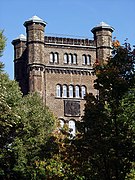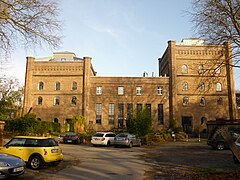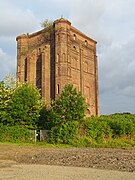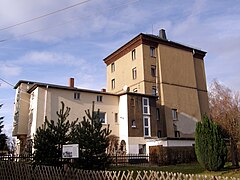Malakov Tower
The Malakow Tower (also Malakoff Tower ) is the name given to winding towers with a characteristic design, which were mainly erected in continental Europe from the 1850s to 1870s , but occasionally up to the end of the 19th century.
They are massive masonry structures with a fortress-like architecture. The stable construction of up to three meters thick brick masonry and a stiffened construction inside made it possible to hold the sheaves and to absorb the enormous tensile forces of the hoisting machines . The mighty towers could be found in the districts of the Ruhr area , Saarland , Saxony , Lower and Upper Silesia and in the Aachen area, but also occasionally in Belgium and France . They were mainly used in hard coal mining and in ore and potash salt mining .
As the predominant form of construction, Malakow towers were replaced by steel conveyor frames when there was enough steel available and so large scaffolding could be erected inexpensively.
Origin of name

The originally colloquial name goes back to Fort Malakow , part of the Russian fortress in front of Sevastopol . During the Crimean War from 1853 to 1856, this fortification, the center of which was the stone Malachow Tower ( Russian Малахова башня) built on the hill of the same name , was long besieged and fought over and was finally in September 1855 by French troops under the command of Aimable Pélissier , who was promoted to marshal in recognition of the victory and, on his return to France on July 22, 1859, was named "Duke of Malakov" (Duc de Malakoff) .
The intensive war reporting during the Crimean War and the popular descriptions of the builder of the fort, the Prussian general Eduard von Todleben , who was in Russian service, made the name Malakow or (in French spelling) Malakoff a synonym for strength, monumentality, massiveness and size in the public consciousness and resilience will be.
At the same time, the first of those high shaft towers were built on the coal mines of the Ruhr area, which mark the beginning of industrial mining. Popularly, the name of the hard-fought fort was adopted as the name for such towers, in order to emphasize the resilience of these sometimes more than thirty-meter-high conveyor facilities. Structurally, the fortress tower of Fort Malakow does not resemble the conveyor facilities except for the robust, bulky shape.
The contemporary mining-technical term for such a structure was simply “masonry”. The term “Malakow Tower” was first introduced into technical history in 1928 by Carl Koschwitz.
For reasons similar to those of the winding towers, the name Malakoff Tower was also used for other, massive, purpose-built or military structures that are not related to mining, such as the watchtower built in 1855 at Cologne's Rheinauhafen or which was renamed Fort Malakoff in 1856 Caponier in Mainz .
technology
Malakow towers are defined according to the terminological conventions of modern technology historiography as civil engineering facilities in the early phase of industrial, i.e. machine- assisted , mining.
Towers in the Ruhr area
After the marl layer in the Ruhr area was overcome for the first time in the 1830s and was thus able to exploit coal deposits at depths of more than 100 m, the previous wooden structures were no longer sufficient for the shaft extraction due to increasing loads. The shafts became deeper, larger in their diameters and the carriers became more efficient. Cast iron , established in building construction and bridge construction since the beginning of the 19th century , was too brittle and could not cope with the stresses caused by the frequently occurring load changes and steel or reinforced concrete was not yet available. In order to be able to absorb the high support loads of the rope sheaves, the rope sheave frame within the building was only supported in the masonry (see adjacent sketch). For this purpose, the shaft towers were equipped with brick masonry, some of which was up to 2.50 m thick, and elaborately stiffened internal structures. Traditional, empirically determined constructions were used that originated from conventional carpentry technology and served to deflect the diagonal lateral pulling forces (see trusses ). The constructions of the rope sheave frames within the towers were initially made of wood, but were later replaced by iron constructions to reduce the risk of fire and to absorb higher forces.
The height of the towers initially resulted from the requirements of the dewatering machines (for lifting the mine water), which were mostly housed in buildings outside the towers. The pit water was pumped out of the shaft via a sucker rod. The highest attachment point of the pump's balancer determined the height of the sheave frame. Later, however, the construction heights were determined by the heights of the suspended benches and the associated coal separation. Construction heights of up to just over 33 m are documented.
Despite their massive construction, the masonry shaft towers were exposed to heavy loads due to the constant oscillations caused by the operation of the hoisting machines , which could lead to the destabilization of the masonry. That made the conveyor technology of those years susceptible to repair and therefore expensive. With the perfection of steel technology, the masonry conveyor systems were gradually replaced by iron conveyor frames, at the latest by the beginning of the 1880s, which could be statically calculated more precisely and withstand the stress better. This happened above all with new systems and on the occasion of the deepening of existing shaft systems, in the latter case regularly by pulling such headframes into existing Malakow towers, which in the following period essentially only served as weather protection devices.
architecture
As typical and characteristic features of the Malakow towers, the massive fortress-like tower constructions are clearly to be emphasized. This construction method emerged in the middle of the 19th century, when deeper depths , more complex water retention and improved coal separations required higher headframes and greater support forces had to be intercepted. Before this time, the smaller headframes were either housed in the brick houses that were common at the time and had a simple architecture, or, as in a few exceptions, in sacred house shapes, such as in the Königsborn saltworks near Unna. However, this design had nothing in common with a Malakov tower.
Towers in the Ruhr area
The Malakow towers in the Ruhr area were mainly made of brick walls. Quarry stone walls probably only appeared along the Ruhr. The only remaining representative of this type of wall is the Malakow tower of the Brockhauser Tiefbau colliery in Rauendeller Siepen in Sundern . This tower, which is still preserved as a ruin, has a simple rectangular shape, without an extension or the usual outbuildings. The masonry consists essentially of quarry stone, with the corners being finished in a straight line through the use of planar blocks made of yellow Ruhr sandstone . The simple masonry, which has no horizontal ledges , is loosened up by arched windows of different sizes and unevenly distributed on all four sides. The window reveals , as well as the round arches and window ledges were formed from brick, as they are often found in Romanesque buildings in northern France .
All of the remaining Malakow towers in the Ruhr area are entirely made of brick. They have square or slightly rectangular floor plans, with foundation walls up to 2.5 m thick, which are set off over up to four floors and become narrower at the top. Externally, these floors are recognizable by horizontal cornices running around the building , known in architecture as the cranked cornice . All windows are designed in the shape of a round arch, with the number of windows increasing from floor to floor, sometimes doubled, but then reduced in size. The windows were mostly set off with brick, provided with window sills and longitudinal edges and arches also protruded. Some towers also have rectangular ledge frames around individual windows or were painted with a lower-lying cassette shape. This design element can also be found occasionally in window groups.
Deviating from the purely square or rectangular basic shape, some towers in the area are provided with square or round towers, usually at two corners on one side. These towers reinforce the fortress character, whereby the Malakow tower of the Westhausen colliery in Bodelschwingh near Lütgendortmund with its polygonal towers, in connection with the round roof domes and the cornices borrowed from Ottoman architecture just below the roof edge, almost looks a bit playful. Some towers are also provided with so-called attic zones , a mezzanine floor or an end wall to cover the roof. The roofs are mostly flat, pyramidal centered in the middle, with flat roofs, such as in the Ewald colliery and rounded domes such as in the Westhausen colliery.
Towers in Saxony
The type of construction was less common in the Saxon hard coal mining than in the Ruhr area and the towers were mostly kept very simple, so they did not have the typical appearance of a fortress tower. The most famous and still preserved tower in Saxony is that of the Marienschacht in Bannewitz near Dresden. Also known as the Malakow Tower, but no longer existing structures, are the Glück-Auf-Schachtes in Bannewitz , blown up in 1930, the Beckerschachts in Hänichen , the Persistence shafts in Rippien and the Berglustschachtes in Wilmsdorf . In Lugau-Oelsnitzer coal , there was the double pits Mercury and Pluto shaft ( coal Building Association Gersdorf ) and the Concordia bays I and II, and from the Zwickau coal district only former Deep Bausch Eight II is known of the Erzgebirge coal-share association as a real Malakowturm. The Malakow Tower from Concordia II in Oelsnitz has been preserved, but is now used as a residential building.

Towers in Belgium
A well-known, preserved building in Belgium is the tower of the Hasard colliery in Visé , Liège province , Wallonia .
Towers in the Netherlands
- Heerlen Oranje-Nassau Colliery 1, Shaft 2, (now a museum)
- Kerkrade Domaniale Zeche, Bleijerheide Zeche Neuprick Catharinaschacht (demolished).
Towers in Poland (Lower Silesia)
- Kopalnia Węgla Kamiennego Wałbrzych , hard coal mine in Wałbrzych (German: Waldburg)
- Kopalnia Węgla Kamiennego Victoria , Glückhilf-Friedenshoffnung hard coal mine in Sobięcin (until 1945 German: Hermsdorf)
Preserved structures
In the Ruhr mining industry
14 of the formerly more than 130 Malakow towers in the Ruhr area are still preserved today, all of which are listed . All structures are designed as shaft towers, but only twelve of them are undisputedly regarded as Malakov towers in the narrower sense.
Following a classification by the industrial archaeologist Rainer Slotta , all of the remaining 14 towers can be classified into five categories, which were shown in the sortable table below.

The two disputed Malakow towers are the above-ground conveyor systems of shafts 1 and 2 of the Carolinenglück colliery , which, according to Ludwig Achepohl, were not built in a masonry construction typical of a Malakow tower, but originally had wooden or iron structures and were around the headframe of the Alte Haase colliery, listed as a Malakow Tower by the city of Sprockhövel , where a rope sheave frame was built in 1897 based on a traction sheave conveyor developed by Carl Friedrich Koepe . The iron headframe protruded 15 m from the 25 m high shaft building, which was only assigned a weather protection function. Also, the time lag between the beginning of the drilling at the Julie shaft in 1874 and the completion of the tower in 1898 at the age of 24 no longer represents a typical connection between drilling and tower construction for Malakov towers. As a rule, the deviations and tower structures were temporal made in parallel.
According to the Ruhr Regional Association, the daytime facilities of the Westhausen colliery are among the most architecturally significant in the Ruhr area. The Malakow Tower from 1873 has two "castle turrets" on one long side, in which there were escape stairs in case of fire.
Another particularly interesting industrial cultural monument is the Malakow tower of the Prosper II colliery in Bottrop, which was built in 1872. It is the only winding tower in Europe where a Malakow tower and the headframe that was later moved in have been preserved in this condition.
The winding tower system of the former Holland I / II colliery in Gelsenkirchen, built between 1856 and 1860 and consisting of two connected Malakow towers , is the only double Malakow tower that has ever been preserved. The two headframes were demolished in the late 1960s and the towers now house apartments.
The last to be mentioned is the Malakow tower of the Julius-Philipp colliery , which has now been completely renovated and houses the medical history collection of the Ruhr University Bochum .
More mines
- Mining Museum Mechernich ( Eifel ): The "Dreckschaach", as the last remaining winding tower of the former lead mine union Mechernich Works (GMW) is still popularly called, is a shaft tower with a polygonal floor plan. Built in the 1890s, it was initially used as a conveying shaft, later only as a cable car shaft and finally for hanging in dead rock . This is where today's name "Dreckschacht" comes from. Today the listed tower is part of the mining museum and can be visited.
- The ruins of the stone Adolph shaft winding tower of the Pfingstwiese pit, a relic of the Ems lead-zinc ore mining, are in the Pitschbach valley in a forest near Bad Ems . The tower, completed in 1873, differs significantly from the structures commonly known as the Malakow Tower. The typical architectural features are missing, especially the massive supporting masonry that supports the conveyor system. With its four-storey design, the rectangular quarry stone building with its saddle roof shape looks more like an ordinary house and may have served as an enclosure for a separate support structure made of wood or steel (pulley chair).
- Walter-Schneider-Schächte (formerly called Ernst-Schächte), Helbra : The Malakow tower, including the machine building, shaft 4, built in 1885/86 is still preserved today from the entire copper mine . Although it is a listed building, it is in a desolate condition.
- Marienschacht , Bannewitz near Dresden : The winding tower of the Marienschacht built in 1891 was one of the last Malakow towers built in Germany. The tower with the machine house is a listed building and is extremely well preserved.
Industrial buildings without a conveyor
- Duisburg : Lifting tower of the Trajektanstalt built in 1854–56 in Homberg / Niederrhein (today Duisburg-Homberg)
- Sprockhövel : Suspended bench cladding of the Alte Haase colliery , erected in 1897 at the same time as the pulley frame
Other military and functional buildings not related to mining
- Bremen : In 1873 a water tower was built on the Stadtwerder , popularly known as the Upside Down Chest of Drawers and architecturally reminiscent of a Malakow tower;
- Ingelheim : In 1856 a tower in the city wall, previously called the Alte Wache , was renamed the Malakoffturm ;
- Cologne : Malakoffturm at Rheinauhafen (watchtower) built in 1855 ;
- Luxembourg : Tour Malakoff , built in 1861, the youngest part of the city fortifications ;
- Mainz : 1843 built as a federal fortress and after 1856 Battle of Malakoff called caponier , since 1871 part of imperial fortress Mainz. After 1919 razed and partly broken off;
- Neusäß near Augsburg: Malakow Tower in the enclosing wall of Hammel Castle , a defensive tower that was given its current appearance in 1856.
Photo gallery
The Malakow tower of Concordiaschacht II in Oelsnitz / Erzgebirge used as a residential building
Malakow Tower in Helbra , Saxony-Anhalt
Tower inside, on the left the drawn-in steel frame, on the right the masonry, in the corner one of the octagonal stairwells with a spiral staircase (looking up).
See also
literature
- Modern specialist literature
- Johannes Biecker, Walter Buschmann : Mining architecture . Study publisher Dr. N. Brockmeyer, Bochum 1986, ISBN 3-88339-517-X .
- Bernhard Becher, Hilla Becher, Heinrich Schönberg, Jan Werth: The architecture of the mining and water towers (= industrial architecture of the 19th century / studies of the art of the 19th century . Volume 13 ). Prestel Verlag, Munich 1971, ISBN 3-7913-0323-6 (Contains among other things: The technical development of the headframes and towers of the mining industry by Heinrich Schönberg).
- Bernhard Becher, Hilla Becher: Headframes - Chevalements - Mineheads . Ed .: Museum Folkwang. Munich 1985, ISBN 3-88814-173-7 (exhibition catalog 4 languages (de / fr / it / en)).
- Rainer Slotta: Malakoff towers, mining shaft towers and their relationship to fortress architecture . In: Der Anschnitt, Association of Friends of Art and Culture in Mining . Volume 53, Issue 1. German Mining Museum, Bochum 2001, p. 28-42 .
- Wolfgang Reichel, Manfred Schauer: The Döhlener basin near Dresden . Coal mining in the Döhlener basin from 1542 to 1967. In: State Office for Environment, Agriculture and Geology (Hrsg.): Mining in Saxony . tape 12 . Dresden 2007, ISBN 3-9811421-0-1 ( Online [PDF; 31.9 MB ; accessed on April 29, 2019]).
- Contemporary works
- Carl Erdmann: Iron winding towers . In: Journal of the Association of German Engineers . tape XVII , 1873, Sp. 399-404 .
- A. Eichenauer: The pulley frames of the mine conveyor systems . Baumgärtner's bookstore, Leipzig 1877.
- Julius Ritter von Hauer: The mining machines . 3. Edition. Verlag von Arthur Felix, Leipzig 1885 (with an atlas of 30 lithographed plates).
Web links
Individual evidence
- ↑ Slotta: Malakofftürme, ... In: The cut . Volume 53, Issue 1, pp. 31 (Malakoff tower on the Alte Haase colliery , Sprockhövel , erb. 1897/1898).
- ^ Walter Buschmann: Malakowtürme. Rheinische Industriekultur e. V., accessed April 22, 2015 .
- ↑ Slotta: Malakofftürme, ... In: The cut . Volume 53, Issue 1, pp. 34 .
- ↑ Slotta: Malakofftürme, ... In: The cut . Volume 53, Issue 1, pp. 37 .
- ↑ Slotta: Malakofftürme, ... In: The cut . Volume 53, Issue 1, pp. 41 .
- ↑ Carl Koschwitz: The buildings on the coal mines of the Ruhr area . Ed .: Technical University of Berlin. Girardet Verlag, Essen September 22, 1928, p. 26th ff . (Dissertation).
- ^ A b c Wilhelm Busch: F. Schupp, M. Kremmer - Bergbauarchitektur 1919–1974 . Ed .: State Conservator Rhineland. Rheinland Verlag, Cologne 1980, p. 23-32 .
- ↑ Biecker, Buschmann: Bergbauarchitektur . 1986, p. 40 .
- ↑ a b Biecker, Buschmann: Bergbauarchitektur . 1986, p. 38 .
- ↑ Slotta: Malakofftürme, ... In: The cut . Volume 53, Issue 1, pp. 28 f .
- ^ A b c Rainer Slotta: Technical monuments in the Federal Republic of Germany . Mining Museum, Bochum 1975, p. 63-67 .
- ↑ a b Reichel, Schauer: The Döhlen basin near Dresden . In: Mining in Saxony . 2007, p. 295-299, 338-240 .
- ^ Reichel, Schauer: The Döhlener basin near Dresden . In: Mining in Saxony . 2007, p. 211 .
- ↑ Silvio Janetz, Silvio mare: The Döhlener basin . Story of a landscape. Ed .: Silvio Janetz. Berlin 2006, p. 24–25 ( online [PDF; 1.9 MB ; accessed on April 29, 2019]).
- ↑ Slotta: Malakofftürme, ... In: The cut . Volume 53, Issue 1, pp. 29-32 .
- ↑ Ludwig Achepohl: The RWTH mine industrial area . 2nd Edition. Verlag Alfred Silbermann, Essen / Leipzig 1894, p. 81 .
- ↑ List of monuments of the city of Sprockhövel. City of Sprockhövel, July 2007, accessed on August 29, 2009 .
- ^ Westhausen colliery. In: Route Industrial Culture. Regionalverband Ruhr, accessed on December 28, 2012 .
- ^ Medical history collection of the RUB. Ruhr University Bochum, August 18, 2015, accessed on November 30, 2015 .
- ↑ 60 years ago: the end of "Spandau". City of Mechernich, December 29, 2017, accessed on April 29, 2019 .
- ↑ Malakov Tower. Mining Museum Mechernich, 2005, archived from the original on September 5, 2011 ; accessed on April 29, 2019 (original website no longer available).
- ↑ Frank Girmann : On the history of the Ems lead-zinc ore mining. Emser Mining Museum, March 2015, accessed on February 10, 2016 .
- ↑ Historical pictures of Bad Ems. Rhein-Zeitung, archived from the original on February 10, 2016 ; Retrieved on February 10, 2016 (original website no longer available).
- ↑ Ernst-Schächte, later Walter-Schneider-Schächte. In: Mansfeld copper traces. Archived from the original on August 19, 2016 ; accessed on April 29, 2019 (original website no longer available).
- ↑ Marienschacht Bannewitz. Bergsicherung Freital GmbH, archived from the original on October 30, 2010 ; accessed on April 29, 2019 (original website no longer available).











